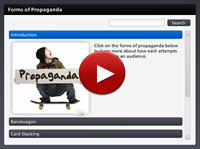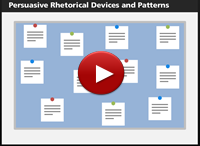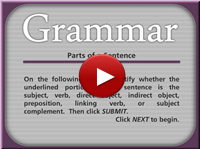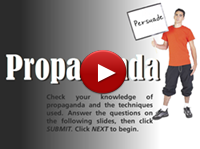
Emotional Appeals and Propaganda
 Propaganda, whether spoken or written, has been used for centuries to try to sway the attitude of a group of people toward an idea or action. Many speeches reference historic events or are given for a historic occasion. Political speeches or speeches that reference politics are common sources of propaganda. Some speeches include storytelling and memorable phrases to connect with the audience.
Propaganda, whether spoken or written, has been used for centuries to try to sway the attitude of a group of people toward an idea or action. Many speeches reference historic events or are given for a historic occasion. Political speeches or speeches that reference politics are common sources of propaganda. Some speeches include storytelling and memorable phrases to connect with the audience.
While the word "propaganda" often carries a negative connotation, it is not always bad. For example, non-profit organizations use propaganda to make students aware of and prevent bullying in schools. The U.S. government also used propaganda strategies to convince the American people to conserve resources during World War II. As an American consumer, however, you are already familiar with a number of propaganda devices that are used to sell you products or services. Advertisements and commercials use many of the same rhetorical devices used in propaganda.

Click on the forms of propaganda in the learning object to learn more about how each attempts to persuade an audience. Click the player button to begin.
Download a printable version of the interactivity.
Persuasive Rhetorical Devices and Patterns
Propaganda piggybacks on common rhetorical forms. It may use logos to appeal to the audience's logic by using facts, examples, or andecotes and scenarios. Authority figures are used in propaganda, as well as explanations of cause and effect, to give credibility to an argument. Propaganda can appeal to the emotions of an audience through pathos with the word choices and images that evoke certain feelings. To appeal to audience's ethics, propaganda creates a credible ethos through tone and establishing the qualifications of the author.
 Learn about rhetorical devices and patterns that are used in persuasive speeches and writing to persuade an audience to listen and empathize with their opinions and ideas in this learning object. Click the player button to begin.
Learn about rhetorical devices and patterns that are used in persuasive speeches and writing to persuade an audience to listen and empathize with their opinions and ideas in this learning object. Click the player button to begin.
Download a printable version of the interactivity above.
Analyzing Nonfiction and Rhetoric
When reading nonfiction and analyzing the rhetoric used it in, it helps to have a system in place. Follow these steps:
- Read the text twice if necessary to understand it.
- Find the thesis or main idea(s).
- Determine who the writer is and ask: Is the person an authority? What is his/her bias?
- Determine who the audience is and the tone the author has chosen to use with the audience.
- Identify the use of any rhetorical devices and their effects on how the audience perceives the message.
- Separate evidence and commentary. In other words, what is fact and what is opinion?
- Put the author’s message into your own words.
- Research the historical context of the text.
Propaganda in Sermon
 Puritans of early America used concepts of propaganda in order to keep alive their beliefs. Puritan minister Jonathan Edwards made a name for himself with his “hell and damnation” sermons. Edwards helped bring about the Great Awakening, a religious revival that took place in the 1730s. Edwards saw man as basically evil and God as both distant and punishing. Although he was a Puritan, he also believed in the philosophy of the Enlightenment that helped to bring about the American Revolution. He believed in science, experience, and reason as sources of knowledge and that the power of human will could shape a man’s destiny. As a leader of the Great Awakening, however, he emphasized emotion to make religion both more popular and more democratic.
Puritans of early America used concepts of propaganda in order to keep alive their beliefs. Puritan minister Jonathan Edwards made a name for himself with his “hell and damnation” sermons. Edwards helped bring about the Great Awakening, a religious revival that took place in the 1730s. Edwards saw man as basically evil and God as both distant and punishing. Although he was a Puritan, he also believed in the philosophy of the Enlightenment that helped to bring about the American Revolution. He believed in science, experience, and reason as sources of knowledge and that the power of human will could shape a man’s destiny. As a leader of the Great Awakening, however, he emphasized emotion to make religion both more popular and more democratic.
Fear is a powerful propaganda tool and one which Edwards employed to great effect in “Sinners in the Hands of an Angry God,” a sermon which lasted nearly six hours on a July day in 1741. Nothing motivates and blinds an audience like fear. It is a simple technique that is still used today. Edwards used obvious and pointed elements of fear to persuade his audience to change their behavior and thinking.When you read the excerpt from “Sinners in the Hands of an Angry God,” you will see that Edwards makes both emotional (pathos) and logic (logos) appeals. His ethos is found in his tone, which goes from one of threatening to derision to hopeful.
![]() Using the analyzing nonfiction and rhetoric techniques, please read this excerpt from Edward’s sermon "Sinners in the Hands of an Angry God."
Consider how his audience might have reacted to the sermon. What techniques does he use to create such an effect on the audience? Which lines are particularly memorable, and why?
Using the analyzing nonfiction and rhetoric techniques, please read this excerpt from Edward’s sermon "Sinners in the Hands of an Angry God."
Consider how his audience might have reacted to the sermon. What techniques does he use to create such an effect on the audience? Which lines are particularly memorable, and why?
Take note of the following lines and the tone that each takes:
- Frightening: “There is nothing between you and Hell but air.”
- Disdainful or mocking: “You are probably not sensible of this.”
- Scornful or intimidating: “…your healthy constitution, and your own care and prudence, and best contrivance, and all your righteousness, would have no more influence to uphold you and keep you out of hell, than a spider’s web….”
- Agitated or distressed: “…your guilt…is constantly increasing, and you are treasuring up more wrath; the waters are constantly rising and waxing more and more mighty…if god should only withdraw his hand from the floodgate, it would immediately fly open, and the fiery floods…would rush forth with inconceivable fury…”
- Hopeful: “God stands ready to pity you; this is a day of mercy…”
- Empathetic: ”It would be dreadful to suffer this fierceness and wrath…”
- Calming: “And now you have an extraordinary opportunity, a day wherein Christ has thrown the door of mercy wide open…”
- Serene or pleased: “…many are now in a happy state, with their hearts filled with love…”
![]() Check your knowledge of propaganda and the techniques used. For each question in this non-graded activity, drag and drop the correct answer to each blank provided. Click the player button to get started.
Check your knowledge of propaganda and the techniques used. For each question in this non-graded activity, drag and drop the correct answer to each blank provided. Click the player button to get started.
Grammar – Parts of a Sentence
![]() Remember, the basic sentence structures include a subject and a verb and sometimes a direct object. The other parts of a sentence give the reader more detail and context. Review the parts of the sentence:
Remember, the basic sentence structures include a subject and a verb and sometimes a direct object. The other parts of a sentence give the reader more detail and context. Review the parts of the sentence:
Subject: The “doer” of the action.
The student wrote a poem for his project in the library.
Verb: The action or state of being about the subject.
The student wrote a poem for his project in the library.
Direct Object: The “recipient” of the action.
The student wrote a poem for his project in the library.
Indirect Object: Answers the question to or for whom.
The student wrote his teacher a poem for his project in the library.
Preposition: Connects another noun to a sentence.
The student wrote a poem for his project in the library.
Linking Verb: Links the subject to words that rename or describe the
subject.
She is president of the school council.
Subject Complement: Word(s) that rename or describe the subject.
She is president of the school council.
Grammar Review – Parts of a Sentence 
![]() In this non-graded activity, identify whether the underlined portion in the sentence is the subject, verb, direct object, indirect object, preposition, linking verb, or subject complement. Click the player button to get started.
In this non-graded activity, identify whether the underlined portion in the sentence is the subject, verb, direct object, indirect object, preposition, linking verb, or subject complement. Click the player button to get started.



